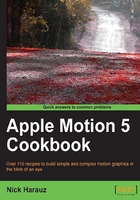
上QQ阅读APP看书,第一时间看更新
Managing the Layers tab
In some of the previous recipes, you may have seen that the Layers tab can become a very busy place. It's important as Motion graphic designers to feel comfortable where we're working. Let's look at a few tricks we can use to manage our Layers tab as we work in Motion.
How to do it...
- Launch Motion. Under Composition, select the Pulse category and choose Pulse – Open. Click Open a copy.
- The project has three groups comprising of various elements from the project. Press Command + 1 to close the File Browser and Command + 7 to close the Timeline, so that we can have a little more room to view our Layers tab.
- Let's play back the project to get a feel for it. Press the Space bar. This project consists of four different views of our animating circles and pulses.
- Let's look at this project a bit deeper. Go to the beginning of the project. Click the disclosure triangle for the Text Elements group, as shown in the following screenshot. Notice how the group is slightly less highlighted than the Camera Light Graphics and Background Elements groups. This indicates that at the current frame, this group doesn't exist. We get further confirmation of this by looking in our mini-Timeline and seeing the Text Elements group start a lot later. Press Shift + I to move to the in-point of the group.
Notice how the group now becomes highlighted but the Subtitle layer does not, as shown in the following screenshot:

- Drag your playhead forward until you see the word Subtitle onscreen or go to frame
273. Notice it's now highlighted. Hit the disclosure triangle for the Subtitle group. Notice that there is a Sequence Text behavior on the text. (We will be going in depth with behaviors in Chapter 3, Making It Move with Behaviors, but right now think of it as what's causing the text to animate in). Sometimes when we add filters, masks, and behaviors to clips, our workspace in the Layers tab can get cluttered. We can easily turn off the visibility of these filters, behaviors, and masks at the bottom of the Layers tab. Press the gear icon (shown in the following screenshot) and notice how the Sequence Text disappears. Press it again so you can see it.
- When we work, it's also advantageous to solo elements in the project. It allows us to focus our work rather than worry about hundreds of items. To see the layers in the Text Elements group by themselves, select it and click the square within the rectangle icon. Notice how the graphic disappears and the text moves slightly to the side. Click it again to unsolo it.
- Close the Text Elements group and open the Cameras Light Graphics group. Notice there are four scenes in this group that correspond to the four circle and pulse animations that take place over time. Get a feel for when each scene starts and stops by looking in the Layers tab and in the mini-Timeline for when a group is highlighted.
- Twirl open scenes four through one by clicking the disclosure triangle for each of them. This may cause some of the layers to go outside the view, and in order to see them you have to scroll. Instead, click the icon at the bottom-left of the Layers tab with the little head on it. Drag the slider to your right to resize the layers.
- Close the Camera Lights and Graphics group.